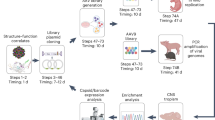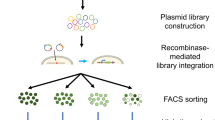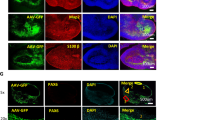Abstract
Targeting of gene transfer at the level of cell entry is one of the most attractive challenges in vector development. However, attempts to redirect adenovirus vectors to alternative receptors by engineering the capsid-coding region have shown limited success because proper targeting ligand–receptor systems on the cells of interest are generally unknown. Systematic approaches to generate adenovirus vectors targeting any given cell type need to be developed to achieve this goal. Here, we constructed an adenovirus library that was generated by a Cre-lox-mediated in vitro recombination between an adenoviral fiber-modified plasmid library and genomic DNA to display random peptides on a fiber knob. As proof of concept, we screened the adenovirus display library on a glioma cell line and observed selection of several particular peptide sequences. The targeted vector carrying the most frequently isolated peptide significantly enhanced gene transduction in the glioma cell line but not in many other cell lines. Because the insertion of a pre-selected peptide into a fiber knob often fails to generate an adenovirus vector, the selection of targeting peptides is highly useful in the context of the adenoviral capsid. This vector-screening system can facilitate the development of a targeted adenovirus vector for a variety of applications in medicine.
This is a preview of subscription content, access via your institution
Access options
Subscribe to this journal
Receive 12 print issues and online access
$259.00 per year
only $21.58 per issue
Buy this article
- Purchase on Springer Link
- Instant access to full article PDF
Prices may be subject to local taxes which are calculated during checkout





Similar content being viewed by others
References
Zhang WW . Development and application of adenoviral vectors for gene therapy of cancer. Cancer Gene Ther 1999; 6: 113–138.
Volpers C, Kochanek S . Adenoviral vectors for gene transfer and therapy. J Gene Med 2004; 6 (Suppl 1): S164–S171.
Bergelson JM, Cunningham JA, Droguett G, Kurt-Jones EA, Krithivas A, Hong JS et al. Isolation of a common receptor for Coxsackie B viruses and adenoviruses 2 and 5. Science 1997; 275: 1320–1323.
Tomko RP, Xu R, Philipson L . HCAR and MCAR: the human and mouse cellular receptors for subgroup C adenoviruses and group B coxsackieviruses. Proc Natl Acad Sci USA 1997; 94: 3352–3356.
Bai M, Harfe B, Freimuth P . Mutations that alter an Arg-Gly-Asp (RGD) sequence in the adenovirus type 2 penton base protein abolish its cell-rounding activity and delay virus reproduction in flat cells. J Virol 1993; 67: 5198–5205.
Wickham TJ, Mathias P, Cheresh DA, Nemerow GR . Integrins alpha v beta 3 and alpha v beta 5 promote adenovirus internalization but not virus attachment. Cell 1993; 73: 309–319.
Douglas JT, Rogers BE, Rosenfeld ME, Michael SI, Feng M, Curiel DT . Targeted gene delivery by tropism-modified adenoviral vectors. Nat Biotechnol 1996; 14: 1574–1578.
Wickham TJ, Segal DM, Roelvink PW, Carrion ME, Lizonova A, Lee GM et al. Targeted adenovirus gene transfer to endothelial and smooth muscle cells by using bispecific antibodies. J Virol 1996; 70: 6831–6838.
Miller CR, Buchsbaum DJ, Reynolds PN, Douglas JT, Gillespie GY, Mayo MS et al. Differential susceptibility of primary and established human glioma cells to adenovirus infection: targeting via the epidermal growth factor receptor achieves fiber receptor-independent gene transfer. Cancer Res 1998; 58: 5738–5748.
Havenga MJ, Lemckert AA, Grimbergen JM, Vogels R, Huisman LG, Valerio D et al. Improved adenovirus vectors for infection of cardiovascular tissues. J Virol 2001; 75: 3335–3342.
Zabner J, Chillon M, Grunst T, Moninger TO, Davidson BL, Gregory R et al. A chimeric type 2 adenovirus vector with a type 17 fiber enhances gene transfer to human airway epithelia. J Virol 1999; 73: 8689–8695.
Shayakhmetov DM, Papayannopoulou T, Stamatoyannopoulos G, Lieber A . Efficient gene transfer into human CD34(+) cells by a retargeted adenovirus vector. J Virol 2000; 74: 2567–2583.
Krasnykh V, Dmitriev I, Mikheeva G, Miller CR, Belousova N, Curiel DT . Characterization of an adenovirus vector containing a heterologous peptide epitope in the HI loop of the fiber knob. J Virol 1998; 72: 1844–1852.
Dmitriev I, Krasnykh V, Miller CR, Wang M, Kashentseva E, Mikheeva G et al. An adenovirus vector with genetically modified fibers demonstrates expanded tropism via utilization of a coxsackievirus and adenovirus receptor-independent cell entry mechanism. J Virol 1998; 72: 9706–9713.
Yoshida Y, Sadata A, Zhang W, Saito K, Shinoura N, Hamada H . Generation of fiber-mutant recombinant adenoviruses for gene therapy of malignant glioma. Hum Gene Ther 1998; 9: 2503–2515.
Douglas JT, Miller CR, Kim M, Dmitriev I, Mikheeva G, Krasnykh V et al. A system for the propagation of adenoviral vectors with genetically modified receptor specificities. Nat Biotechnol 1999; 17: 470–475.
Arap W, Haedicke W, Bernasconi M, Kain R, Rajotte D, Krajewski S et al. Targeting the prostate for destruction through a vascular address. Proc Natl Acad Sci USA 2002; 99: 1527–1531.
Arap W, Kolonin MG, Trepel M, Lahdenranta J, Cardo-Vila M, Giordano RJ et al. Steps toward mapping the human vasculature by phage display. Nat Med 2002; 8: 121–127.
Laakkonen P, Porkka K, Hoffman JA, Ruoslahti E . A tumor-homing peptide with a targeting specificity related to lymphatic vessels. Nat Med 2002; 8: 751–755.
Nicklin SA, Von Seggern DJ, Work LM, Pek DC, Dominiczak AF, Nemerow GR et al. Ablating adenovirus type 5 fiber-CAR binding and HI loop insertion of the SIGYPLP peptide generate an endothelial cell-selective adenovirus. Mol Ther 2001; 4: 534–542.
Joung I, Harber G, Gerecke KM, Carroll SL, Collawn JF, Engler JA . Improved gene delivery into neuroglial cells using a fiber-modified adenovirus vector. Biochem Biophys Res Commun 2005; 328: 1182–1187.
Nicklin SA, White SJ, Nicol CG, Von Seggern DJ, Baker AH . In vitro and in vivo characterisation of endothelial cell selective adenoviral vectors. J Gene Med 2004; 6: 300–308.
Muller OJ, Kaul F, Weitzman MD, Pasqualini R, Arap W, Kelinshmidt JA et al. Random peptide libraries displayed on adeno-associated virus to select for targeted gene therapy vectors. Nat Biotechnol 2003; 21: 1040–1046.
Aoki K, Barker C, Danthinne X, Imperiale MJ, Nabel GJ . Efficient generation of recombinant adenoviral vectors by Cre-lox recombination in vitro. Mol Med 1999; 5: 224–231.
Hatanaka K, Ohnami S, Yoshida K, Miura Y, Aoyagi K, Sasaki H et al. A simple and efficient method for constructing an adenoviral cDNA expression library. Mol Ther 2003; 8: 158–166.
Einfeld DA, Schroeder R, Roelvink PW, Lizonova A, King CR, Kovesdi I et al. Reducing the native tropism of adenovirus vectors requires removal of both CAR and integrin interactions. J Virol 2001; 75: 11284–11291.
D'Halluin JC, Milleville M, Martin GR, Boulanger P . Morphogenesis of human adenovirus type 2 studied with fiber- and fiber and penton base-defective temperature-sensitive mutants. J Virol 1980; 33: 88–99.
Hong JS, Engler JA . Domains required for assembly of adenovirus type 2 fiber trimers. J Virol 1996; 70: 7071–7078.
Legrand V, Spehner D, Schlesinger Y, Settelen N, Pavirani A, Mehtali M . Fiberless recombinant adenoviruses: virus maturation and infectivity in the absence of fiber. J Virol 1999; 73: 907–919.
Mori T, Arakawa H, Tokino T, Mineura K, Nakamura Y . Significant increase of adenovirus infectivity in glioma cell lines by extracellular domain of hCAR. Oncol Res 1999; 11: 513–521.
Bupp K, Roth MJ . Altering retroviral tropism using a random-display envelope library. Mol Ther 2002; 5: 329–335.
Khare PD, Rosales AG, Bailey KR, Russell SJ, Federspiel MJ . Epitope selection from an uncensored peptide library displayed on avian leukosis virus. Virology 2003; 315: 313–321.
Hartl I, Schneider RM, Sun Y, Medvedovska J, Chadwick MP, Russell SJ et al. Library-based selection of retroviruses selectively spreading through matrix metalloprotease-positive cells. Gene Ther 2005; 12: 918–926.
Mizuguchi H, Koizumi N, Hosono T, Utoguchi N, Watanabe Y, Kay MA et al. A simplified system for constructing recombinant adenoviral vectors containing heterologous peptides in the HI loop of their fiber knob. Gene Ther 2001; 8: 730–735.
Nechiporuk T, Urness LD, Keating MT . ETL, a novel seven-transmembrane receptor that is developmentally regulated in the heart. ETL is a member of the secretin family and belongs to the epidermal growth factor-seven-transmembrane subfamily. J Biol Chem 2001; 276: 4150–4157.
Groh V, Rhinehart R, Secrist H, Bauer S, Grabstein KH, Spies T . Broad tumor-associated expression and recognition by tumor-derived gamma delta T cells of MICA and MICB. Proc Natl Acad Sci USA 1999; 96: 6879–6884.
Everts B, van der Poel HG . Replication-selective oncolytic viruses in the treatment of cancer. Cancer Gene Ther 2005; 12: 141–161.
Wildner O . Comparison of replication-selective, oncolytic viruses for the treatment of human cancers. Curr Opin Mol Ther 2003; 5: 351–361.
Miyake S, Makimura M, Kanegae Y, Harada S, Sato Y, Takamori K et al. Efficient generation of recombinant adenoviruses using adenovirus DNA-terminal protein complex and a cosmid bearing the full-length virus genome. Proc Natl Acad Sci USA 1996; 93: 1320–1324.
Communal C, Huq F, Lebeche D, Mestel C, Gwathmey JK, Hajjar RJ . Decreased efficiency of adenovirus-mediated gene transfer in aging cardiomyocytes. Circulation 2003; 107: 1170–1175.
Aoki K, Furuhata S, Hatanaka K, Maeda M, Remy JS, Behr J-P et al. Polyethylenimine-mediated gene transfer into pancreatic tumor dissemination in the murine peritoneal cavity. Gene Ther 2001; 8: 508–514.
Acknowledgements
This work was supported in part by a grant-in-aid for the 3rd Term Comprehensive 10-Year Strategy for Cancer Control from the Ministry of Health, Labour and Welfare of Japan, grants-in-aid for Cancer Research from the Ministry of Health, Labour and Welfare of Japan, and a grant-in-aid (#W81XWH-05-1-0035) from the Department of Defense of the United States. We thank Gary Quinn for useful discussion and Miwa Kushida and Atushi Kondo for technical help. Y Miura, K Hatanaka and T Nishimoto are awardees of a Research Resident Fellowship from the Foundation (Japan) for the Promotion of Science.
Author information
Authors and Affiliations
Corresponding author
Rights and permissions
About this article
Cite this article
Miura, Y., Yoshida, K., Nishimoto, T. et al. Direct selection of targeted adenovirus vectors by random peptide display on the fiber knob. Gene Ther 14, 1448–1460 (2007). https://doi.org/10.1038/sj.gt.3303007
Received:
Revised:
Accepted:
Published:
Issue Date:
DOI: https://doi.org/10.1038/sj.gt.3303007
Keywords
This article is cited by
-
Unravelling Receptor and RGD Motif Dependence of Retargeted Adenoviral Vectors using Advanced Tumor Model Systems
Scientific Reports (2019)
-
Infectivity-selective Oncolytic Adenovirus Developed by High-throughput Screening of Adenovirus-formatted Library
Molecular Therapy (2013)
-
Oncolytic virus therapy for pancreatic cancer using the adenovirus library displaying random peptides on the fiber knob
Gene Therapy (2009)
-
Neural stem cells target intracranial glioma to deliver an oncolytic adenovirus in vivo
Gene Therapy (2009)



